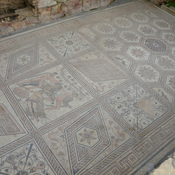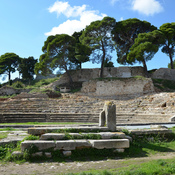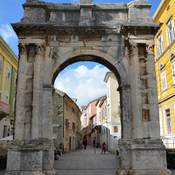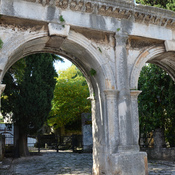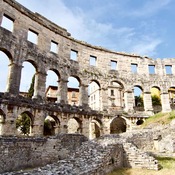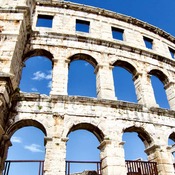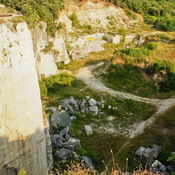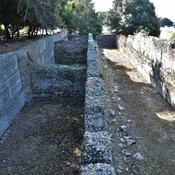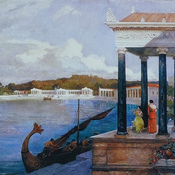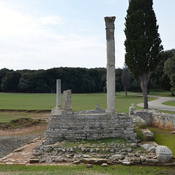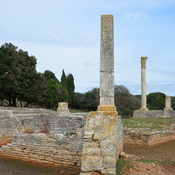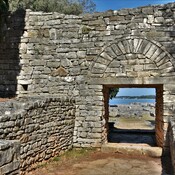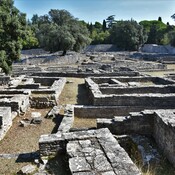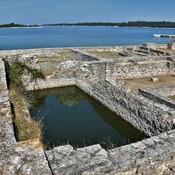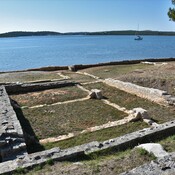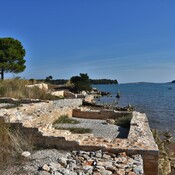Il n'y a pas une annotation en français. Présenté est une annotation en Anglais.
The Temple of Augustus was dedicated to the first Roman emperor, Augustus. It was probably built during the emperor's lifetime at some point between 2 BC and his death in AD 14. It was built on a podium with a tetrastyle prostyle porch of Corinthian columns and measures about 8 m (26 ft) by 17.3 m (57 ft). The richly decorated frieze is similar to that of a somewhat larger and older temple, the Maison Carrée in Nîmes, France.
The temple's dedication originally consisted of bronze letters attached to the portico. Only the attachment holes now remain and much of the text has been destroyed over time. However, it consisted of a standard dedication also found on other Augustan temples, which read:
ROMAE · ET · AUGUSTO · CAESARI · DIVI · F · PATRI · PATRIAE
(Roma and Augustus Caesar, son of the deity, father of the fatherland)
This indicates that the temple was originally also co-dedicated to the goddess Roma, the personification of the city of Rome. Unlike later temples, such as the Temple of Divus Augustus in Rome, the temple was not dedicated to divus (the deified) Augustus - a title only given to the emperor after his death. This, and the temple's architectural style, have allowed archaeologists to date the temple to the late Augustan period, prior to Augustus' death in AD 14.
The temple was part of a triad consisting of three temples. The Temple of Augustus stood at the left side of the central temple, and the similar temple of the goddess Diana stood on the other side of the main temple. Although the larger central temple has not survived, the whole back side of the Temple of Diana is still clearly visible due to its incorporation into the Communal Palace, built in 1296.
1Références
- ↑Temple of Augustus (Pula)
The Temple of Augustus was dedicated to the first Roman emperor, Augustus. It was probably built during the emperor's lifetime at some point between 2 BC and his death in AD 14. It was built on a podium with a tetrastyle prostyle porch of Corinthian columns and measures about 8 m (26 ft) by 17.3 m (57 ft). The richly decorated frieze is similar to that of a somewhat larger and older temple, the Maison Carrée in Nîmes, France.
The temple's dedication originally consisted of bronze letters attached to the portico. Only the attachment holes now remain and much of the text has been destroyed over time. However, it consisted of a standard dedication also found on other Augustan temples, which read:
ROMAE · ET · AUGUSTO · CAESARI · DIVI · F · PATRI · PATRIAE
(Roma and Augustus Caesar, son of the deity, father of the fatherland)
This indicates that the temple was originally also co-dedicated to the goddess Roma, the personification of the city of Rome. Unlike later temples, such as the Temple of Divus Augustus in Rome, the temple was not dedicated to divus (the deified) Augustus - a title only given to the emperor after his death. This, and the temple's architectural style, have allowed archaeologists to date the temple to the late Augustan period, prior to Augustus' death in AD 14.
The temple was part of a triad consisting of three temples. The Temple of Augustus stood at the left side of the central temple, and the similar temple of the goddess Diana stood on the other side of the main temple. Although the larger central temple has not survived, the whole back side of the Temple of Diana is still clearly visible due to its incorporation into the Communal Palace, built in 1296.
1Références
- ↑Temple of Augustus (Pula)
De Tempel van Augustus is een goed bewaard gebleven Romeinse tempel in Pula, Kroatië. Hij is waarschijnlijk gebouwd tussen 2 v.Chr. en 14 n.Chr. en is opgedragen aan Augustus, de eerste keizer van het Romeinse Rijk. De tempel heeft een tetrastyl porticus (vier zuilen aan de voorzijde), en is gebouwd op een podium. Via een trap aan de voorkant is de tempel te bereiken. Het bouwwerk is ongeveer 8 bij 17,3 meter groot. De zuilen zijn in de Korinthische stijl gebouwd. De rijk versierde fries is vergelijkbaar met die van een wat grotere en oudere tempel, de Maison Carrée in Nîmes, Frankrijk. De tempel was onderdeel van een triade, bestaande uit drie tempels. Die van Augustus stond links van de centrale tempel. Rechts daarvan stond een soortgelijke, gewijd aan de godin Diana.
Op de tempel staat de volgende tekst:
ROMAE · ET · AUGUSTO · CAESARI · DIVI · F · PATRI · PATRIAE
(Voor Roma en Augustus Caesar, zoon van een godheid, vader des vaderlands)
Hierdoor weet men dat de tempel ook gewijd was aan de verpersoonlijking van de stad Rome, Roma, die als godin werd vereerd. In tegenstelling tot latere tempels, zoals de Tempel van Augustus in Rome, was deze niet opgedragen aan de vergoddelijkte Augustus, een titel die alleen werd gegeven na de dood van een keizer.1
Références
- ↑Tempel van Augustus (Pula)



